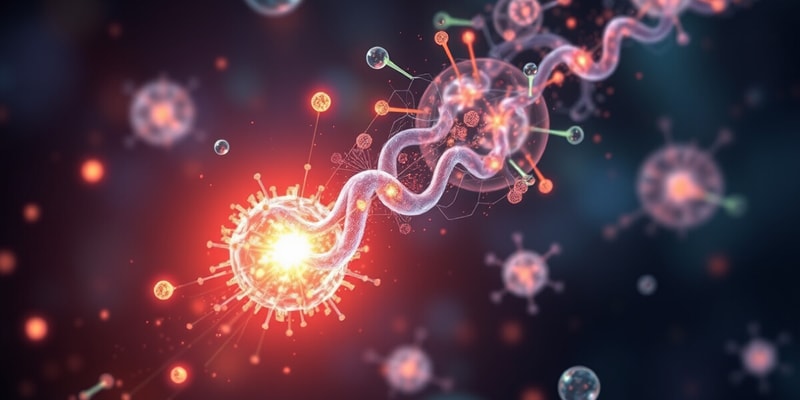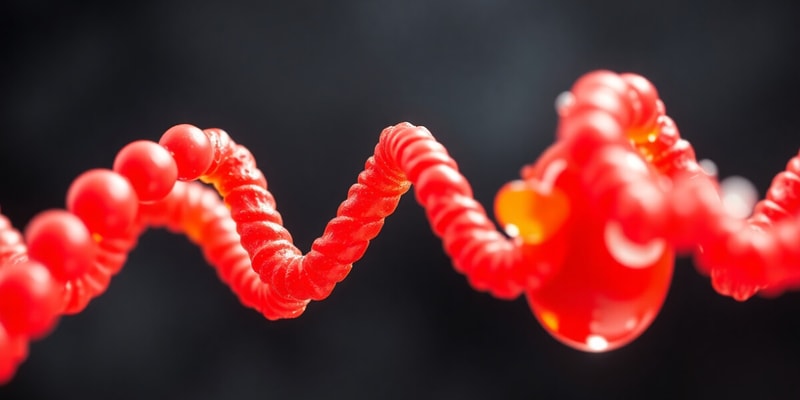Podcast
Questions and Answers
What is the calculated value of ΔS° for the reaction ATP → ADP + Pi at 37 °C?
What is the calculated value of ΔS° for the reaction ATP → ADP + Pi at 37 °C?
What does a negative value of ΔG indicate about the ATP hydrolysis reaction?
What does a negative value of ΔG indicate about the ATP hydrolysis reaction?
Given ΔH° = 250.8 kJ mol−1 and ΔS° = 752 J K−1 mol−1 for protein unfolding, above what temperature will the unfolding be spontaneous?
Given ΔH° = 250.8 kJ mol−1 and ΔS° = 752 J K−1 mol−1 for protein unfolding, above what temperature will the unfolding be spontaneous?
What does the positive value of ΔS° for ATP hydrolysis suggest about the molecular order?
What does the positive value of ΔS° for ATP hydrolysis suggest about the molecular order?
Signup and view all the answers
What is the relationship between ΔH° and ΔG° for the reaction ATP → ADP + Pi?
What is the relationship between ΔH° and ΔG° for the reaction ATP → ADP + Pi?
Signup and view all the answers
What is indicated by a negative ΔH° in the context of ATP hydrolysis?
What is indicated by a negative ΔH° in the context of ATP hydrolysis?
Signup and view all the answers
Which statement is true regarding the thermodynamic nature of protein unfolding?
Which statement is true regarding the thermodynamic nature of protein unfolding?
Signup and view all the answers
At what condition is ΔG° equal to zero for a protein transitioning from folded to unfolded state?
At what condition is ΔG° equal to zero for a protein transitioning from folded to unfolded state?
Signup and view all the answers
How can the formation of new bonds influence the thermodynamic properties of a reaction like ATP to ADP?
How can the formation of new bonds influence the thermodynamic properties of a reaction like ATP to ADP?
Signup and view all the answers
What is the main significance of a spontaneous reaction in terms of equilibrium?
What is the main significance of a spontaneous reaction in terms of equilibrium?
Signup and view all the answers
What can be inferred about the disorder of the system during the ATP to ADP hydrolysis given that ΔS° is positive?
What can be inferred about the disorder of the system during the ATP to ADP hydrolysis given that ΔS° is positive?
Signup and view all the answers
What does the value of ΔH° being negative imply about the ATP hydrolysis process?
What does the value of ΔH° being negative imply about the ATP hydrolysis process?
Signup and view all the answers
Which option correctly describes the relationship between ΔH° and ΔG° for the unfolding of a protein?
Which option correctly describes the relationship between ΔH° and ΔG° for the unfolding of a protein?
Signup and view all the answers
At what condition does the unfolding of a protein transition from spontaneous to non-spontaneous behavior?
At what condition does the unfolding of a protein transition from spontaneous to non-spontaneous behavior?
Signup and view all the answers
What does the calculation of ΔS° for ATP → ADP + Pi reveal about the change in energy distribution?
What does the calculation of ΔS° for ATP → ADP + Pi reveal about the change in energy distribution?
Signup and view all the answers
If the Gibbs free energy change (ΔG) for protein unfolding is zero, what can be deduced?
If the Gibbs free energy change (ΔG) for protein unfolding is zero, what can be deduced?
Signup and view all the answers
How does the temperature influence the process of protein unfolding regarding ΔG°?
How does the temperature influence the process of protein unfolding regarding ΔG°?
Signup and view all the answers
Which statement about the ATP hydrolysis reaction is accurate based on provided thermodynamic values?
Which statement about the ATP hydrolysis reaction is accurate based on provided thermodynamic values?
Signup and view all the answers
What implication does a large ΔH° have on the conformational changes in a protein?
What implication does a large ΔH° have on the conformational changes in a protein?
Signup and view all the answers
Study Notes
Gibbs Free Energy
- Gibbs Free Energy (G) is used to predict the spontaneity (whether a reaction will favor products or reactants).
- A negative value of G is associated with a spontaneous reaction, favoring product formation.
- A positive value of G is associated with a non-spontaneous reaction, favoring reactant formation.
- G can be calculated using the equation: G = H - TS
Calculating Change in Entropy
- The equation: ΔG = ΔH − TΔS can be rearranged to calculate the change in entropy (ΔS): ΔS = (ΔH - ΔG) / T
- For ATP hydrolysis, ΔH = -20.1 kJ/mol, ΔG = -30.5 kJ/mol, and the temperature (T) = 310 K (37 °C), so ΔS = 34.0 J/mol.
ATP Hydrolysis
- The hydrolysis of ATP (ATP → ADP + Pi) has a negative ΔG, indicating it is a spontaneous process.
- The negative ΔH means the enthalpy change is favorable, likely due to the formation of new bonds in the products.
- The positive ΔS means the entropy change is favorable, indicating an increase in disorder as a single molecule (ATP) breaks down into two (ADP and Pi).
Protein Unfolding
- Unfolding of a protein is the process where the protein goes from a folded, active state to an unfolded, inactive state.
- The unfolding of a protein has a positive ΔH, meaning it requires energy (endothermic).
- The positive ΔS means the entropy change is favorable, indicating an increase in disorder as the protein unfolds and becomes more flexible.
- To determine the temperature at which the process becomes spontaneous, set ΔG = 0 and solve for T: T = ΔH / ΔS.
- For the protein unfolding process, ΔH = 250.8 kJ/mol and ΔS = 0.752 kJ/mol.K, resulting in a temperature of 333.6 K (60.6 °C).
- This means that at temperatures above 60.6 °C, the unfolding of the protein will be spontaneous.
Interpretation
- The Gibbs Free Energy equation highlights the interplay between enthalpy, entropy, and temperature.
- Even though a reaction may be enthalpically unfavorable (positive ΔH), it can still be spontaneous under certain conditions if entropy is favorable (positive ΔS) and temperature is sufficiently high.
- Conversely, a reaction may be enthalpically favorable (negative ΔH) but not spontaneous if entropy is unfavorable (negative ΔS) and temperature is low.
Gibbs Free Energy
- The Gibbs Free Energy (ΔG) is a thermodynamic potential that can be used to predict the spontaneity of a process.
- A negative ΔG value indicates a spontaneous process, while a positive ΔG value indicates a non-spontaneous process.
- ΔG is calculated using the equation: ΔG = ΔH - TΔS
- ΔH is the enthalpy change (heat absorbed or released).
- ΔS is the entropy change (change in disorder).
- T is the temperature in Kelvin.
ATP Hydrolysis
- The hydrolysis of ATP to ADP and inorganic phosphate (Pi) has a negative standard Gibbs free energy change (ΔG° = -30.5 kJ mol-1).
- This process is spontaneous and releases energy.
- The standard enthalpy change (ΔH°) for ATP hydrolysis is -20.1 kJ mol-1, indicating that the reaction is exothermic.
- The standard entropy change (ΔS°) for ATP hydrolysis, calculated using the Gibbs free energy equation, is +34 J mol-1.
- The positive entropy change indicates that the process leads to an increase in disorder, as one molecule (ATP) is converted into two molecules (ADP and Pi).
Protein Unfolding
- The unfolding of a protein is characterized by a positive enthalpy change (ΔH° = 250.8 kJ mol-1), indicating that the process is endothermic.
- The unfolding of a protein is also characterized by a positive entropy change (ΔS° = 752 J K-1 mol-1), indicating that the process leads to an increase in disorder.
- When ΔG is 0, the unfolding process is at equilibrium.
- The temperature at which ΔG becomes negative and the process becomes spontaneous is calculated by setting ΔG = 0 and solving for T.
- This temperature is approximately 333 K, or 60 °C.
- At temperatures above 60 °C, the unfolding of the protein is spontaneous because the entropy term (TΔS) dominates the enthalpy term (ΔH).
Summary of Values
- A negative enthalpy change (ΔH) indicates that the process is exothermic and releases heat.
- A positive enthalpy change (ΔH) indicates that the process is endothermic and absorbs heat.
- A negative entropy change (ΔS) indicates that the process leads to a decrease in disorder.
- A positive entropy change (ΔS) indicates that the process leads to an increase in disorder.
Spontaneity
- A negative Gibbs Free Energy change (ΔG) indicates that the process is spontaneous and will occur without the need for energy input.
- A positive Gibbs Free Energy change (ΔG) indicates that the process is non-spontaneous and will require energy input in order to occur.
Studying That Suits You
Use AI to generate personalized quizzes and flashcards to suit your learning preferences.
Related Documents
Description
This quiz explores Gibbs Free Energy, its role in predicting the spontaneity of reactions, and calculations related to entropy change. It includes examples such as ATP hydrolysis, highlighting the significance of ΔG, ΔH, and ΔS in chemical reactions.




